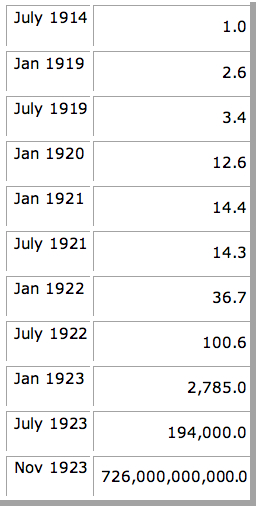Hyperinflation in Weimar Government
In the early 1920s Germany experienced one of the most severe inflations of all time. The inflation was not apparent in 1920, but began showing up in 1921. Thereafter it got steadily worse until it came to an abrupt halt at the end of 1923. At its worst in the second half of 1923, prices rose more than fivefold each week.
Rate of Hyperinflation during the Weimar Government
|
How did this crisis start? In order to pay the costs for WWI, the Government decide to take loans from other countries, a decision made worser due to the Treaty Of Versailles, where the Allies asked Germany to pay reparations worth US$31.4 billion (based on 1921 economy). Economists deemed that it would take Germany until 1988 to pay the full amount.
All this decreased the value of Germany's currency, the Reichmarks. Due to the war efforts alone, the prices of products in Germany went up by 140%. In 1921, prices increased about sixfold,that is, it took six marks at the end of the period to buy what one mark would have bought at the beginning. In 1923, in an extent to increase the value of the Reichmarks, the officials at the Reich bank decided to support the mark by purchasing it in the foreign exchange markets. However as the Weimar government was printing out currency at an alarming rate to pay the reparations.
This caused the value of Reichmarks to decrease. Workers were still given the same salaries. However the price of products started to increase rapidly in July to November of 1923, when prices increased by somewhere between a million and a billion times their previous level.This caused shop owners to not be able to buy stocks for their shops. On the other hand, business owners benefitted from this inflation the most, as all their debts were cleared away. Badly hit were the pensioners, whom with their pension, can only afford a cup of coffee and a slice of bread. Therefore, the hyperinflation period saw drops in standards of living, however also helped certain businessmen bring back their businesses debtless. As the French Government took away Coal mines in Ruhr and workers there were going on strike, the Weimar government were unable to rebuild their economy.Hence Hjalmar Schacht, the new currency commissioner of the Weimar Republic decided to end the period of hyperinflation by introducing a new currency called the Retenmarks. This ended the period of hyperinflation in Germany, and business was back to normal. The prices went down, not back to pre-war standards, but still affordable.
Here is a video to briefly summarise the situation during the Hyperinflation




0 comments:
Post a Comment